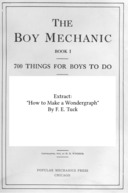All of these devices do employ a rod one end of which is given a motion by a crank. The other end might swing at a point or may oscillate through a point (e.g., through a hole in a guide). They are therefore distinct from the crank rod mechanisms of, say, conventional horizontal steam engines (where one end slides along a line).
In all cases, the rod's motion is entirely constrained mechanically. So while they are sometimes classified as a form of harmonograph, they differ from classic harmonographs in that the motion of the pendulums of a harmonograph is free (constrained by physics, not mechanisms).

Whitaker. "Harmonographs. II. Circular Design." (2001)
Whitaker, Robert J. "Harmonographs. II. Circular Design." American Journal of Physics. Vol. 69, No. 2 (February 2001): 174-183. This is a historical overview of several different "circular harmonograph" mechanisms. (This is part II of a paper by Whitaker on harmonographs; part I was "Harmonographs. I. Pendulum Design", Am. J. Phys, Vol. 69, No. 2 (Feb. 2001): 162ff.) He discusses, inter alia, the following mechanisms (not all of which are cranked rod mechanisms): Pickering's mechanical Lissajous apparatus (1869), Donkin's harmonic curve apparatus (1873), Dechevrens' Campylograph (1900), Ströhrer's apparatus (1905), Pumphery's Cycloidotrope (Hopkins, 1911), Moritz' Cyclo-Harmonograph (1916), Banfield's Photo-Ratiograph (1921), the Wondergraph (early 20th c.; Collins (1921), Stong (1965) and Bulman's Schemagraph (1966), the Spirograph®, and the very complex "Creighton Machine" by Rigge (1915-1924). His bibliography is extensive and most useful.

Stong. "Amateur Scientist" (1965)
Stong, C. L. "Zany Mechanical Devices that Draw the Figures Known As Harmonograms." Scientific American. "Amateur Scientist" column. (May, 1965) (N.B., if you're searching for this, note that the author's name is "Stong," not "Strong.")
This article presents several mechanism, including one by Tom Barnard which shows the construction of a single-cranked-rod mechanism very clearly. (It is equivalent, I think, to the much earlier "Wondergraph" toy (see below), but where the Wondergraph used a nib pen which had to be held at an oblique angle - confusing to 21st century eyes - the Barnard version uses a straight ball-point pen and is therefore easier to interpret as a machine, visually).

The Wondergraph (Toy)
The "Wondergraph" was a single-rod cranked rod mechanism sold as a children's toy in the early 20th century.
A toy collector under the name of "spiroman" has a number of very good images of the Wondergraph and its literature online on his site at http://www.spiroman.freewebspace.com/index.html.
The Strong and the National Museum of Play in Rochester, NY (formerly the Margaret Woodbury Strong Museum of Fascination) has a photograph of instructions for the Wondergraph online. See: http://www.thestrong.org/online-collections/nmop/1/31/109.1340

Tuck. "How to Make a Wondergraph." (1908)
Tuck, F. E. "How to Make a Wondergraph." Popular Mechanics. Vol. 10, No. 5 (May 1908): 343-356. This article was reprinted in the book The Boy Mechanic. Book I. (Chicago: Popular Mechanics Press, 1913.) pp. 436-439. Tuck describes several configurations of mechanisms, not just the one corresponding to the Wondergraph toy.
In 2001 I put an HTML + JPG reprint of the "Boy Mechanic" version of this article online. It is still online (as of mid 2012) at: http://www.marcdatabase.com/~lemur/lemur.com/library-of-antiquarian-technology/philosophical-instruments/boy-mechanic-1913/index.html. That presentation is frozen, however. I don't even have access to the server it is on. It will remain online for as long as it does, and then disappear; it would be unwise to link to it there. The icon at left here, though, links to a PDF re-presentation of the same scans.
This volume of Popular Mechanics has been digitized by Google Books. Here is an extract from it of the Tuck article: popular-mechanics-vol-010-1908-google-wisc-tuck-wondergraph-extract.pdf.
The Boy Mechanic has been digitized by both Project Gutenberg and Google Books. It's easiest to comply with the Project Gutenberg reprinting requirements by simply reproducing the entire volume here (and it's a fun read anyway): 12655-pdf.pdf. The PG version has been transcribed; it is not a simple scan of the text. Here's the Google Books version, which is just a scan: the-boy-mechanic-book-1-1913-google-uc.pdf.

Walton. Popular Science. (1959)
In the December 1959 issue of Popular Science, Harry Walton presented a construction article, "How to Build a Rose Engine with a New Twist" (pp. 154-155). Despite the title, however, the device shown had nothing to do with rose engines (see the discussion of this in the Notebook on 20th century Ornamental Turning literature in English). Rather, it was a cranked pendulum very similar in form to the "Wondergraph."
Walton's article, and the two items of correspondence following it (May 1960, pp. 10-11 and Sept. 1960, p. 16), are online in the Google Books presentation of Popular Science.
All portions of this document not noted otherwise are Copyright © 2012 by David M. MacMillan and Rollande Krandall.
Circuitous Root is a Registered Trademark of David M. MacMillan and Rollande Krandall.
This work is licensed under the Creative Commons "Attribution - ShareAlike" license. See http://creativecommons.org/licenses/by-sa/3.0/ for its terms.
Presented originally by Circuitous Root®
Select Resolution: 0 [other resolutions temporarily disabled due to lack of disk space]